Учебное пособие Издательство Томского политехнического университета 2009
| Вид материала | Учебное пособие |
- Редакционно-издательским советом Томского политехнического университета Издательство, 1434.78kb.
- Редакционно-издательским советом Томского политехнического университета Издательство, 3189.24kb.
- Редакционно-издательским советом Томского политехнического университета Издательство, 2424.52kb.
- Редакционно-издательским советом Томского политехнического университета Издательство, 2585.19kb.
- Редакционно-издательским советом Томского политехнического университета Издательство, 1488.99kb.
- Учебное пособие подготовлено на кафедре философии Томского политехнического университета, 1526.78kb.
- Учебное пособие Издательство Томского политехнического университета Томск 2007, 1320kb.
- Учебное пособие Рекомендовано в качестве учебного пособия Редакционно-издательским, 2331.42kb.
- М. В. Иванова Томск: Издательство Томского политехнического университета, 2008. 177, 2610.26kb.
- Я управления рисками в организации рекомендовано в качестве учебного пособия Редакционно-издательским, 1160.94kb.
Notes
luminary - книжн. светило, светоч
under the master's tutelage - под покровительством мастера
tutelage - опекунство, попечительство
destitute - a. сильно нуждающийся
juxtaposition of light and shadow - наложение света и тени
utilitarian purpose of art - утилитарная (практичная) цель искусства
mentor - наставник, руководитель, ментор
to impose standards on smb - навязывать кому-либо стандарты
to subscribe to all points of the program - подписаться под всеми пунктами программы, зд быть согласным
to gain popularity - завоевать популярность
acclaim - шумно приветствовать
in great demand - быть в большом спросе, быть востребованным
maecenas - меценат
Translation Practice
Высшими достижениями раннего периода Серова являются портреты-картины “Девочка с персиками”(1887) и “Девушка, освещенная солнцем” (1888). В этих произведениях Серов, воспевая юность и красоту, передавая чувство счастья и радости бытия, видел главную свою задачу в непосредственности восприятия модели и природы и убедительности пластических истолкований. В разработке света и цвета, в передаче сложной гармонии рефлексов, в насыщении среды воздухом, в свежести живописного восприятия мира проявлялись черты раннего русского импрессионизма.
С начала 90-х гг. портрет стал основным жанром в творчестве Серова, приобретая новые черты: психологически заостренную характеристику человека и активно выявленное в нем артистическое начало. Излюбленными моделями Серова становятся артисты, художники, писатели … (БСЭ, т. 23,с.308-309)
Task 15. Describe the V. Serov’s painting “Girl in the Sunlight”, using the following vocabulary and the information from the texts.
patches of light - световые пятна
flecks of light - блики ( крапинки) света
highlight - световой эффект
to highlight - выдвигать на передний план, ярко освещать
to be enveloped in atmosphere - быть укутанным атмосферой
to be bathed in sunlight – купаться в солнечном свете
colour-scheme - цветовая гамма
against the background - на фоне
sketchy technique - эскизная техника
brush strokes – мазки кисти
to render = to convey

V. Serov. Girl in the Sunlight (Portrait of Maria Simonovich), 1888
to be imbued with - быть наполненным, пропитанным (чувством, светом)
to be surrounded with an aura of poetic sentiment – быть окруженным аурой поэтичности
Translation Practice
Task 16. Translate the extracts in writing and then retell them in English.
1. “Сватовство майора” Федотова имеет глубокую социальную направленность, в ней бичуются браки без любви, без романтики, представляющие собой прозаичные практические сделки. В центре картины – невеста, разряженная, стыдящаяся, стремящаяся упорхнуть, уйти от опасности. Очень выразительна ее фигура, развернутая в обе стороны и как бы объединяющая всю композицию. А в дверях, на фоне зеленой стены, вырисовывается силуэт жениха – майора, привлеченного капиталом, в придачу к которому он получает еще и привлекательную невесту.
2. Одной из наиболее сильных картин Перова является его “Сельский крестный ход на пасхе”. Печальна картина невежества и убогости деревенской жизни. Серое, мрачное небо, грязь на дороге и голые деревья - весь этот унылый пейзаж усиливает чувство беспросветной тоски. Гротескно изобразив пьяного попа, Перов не идеализирует и крестьян, а правдиво показывает их такими, какие они есть.
3. По инициативе Мясоедова, Перова, Ге, Крамского и других в 1870 году возникло “ Товарищество передвижных художественных выставок”. Товарищество просуществовало до 1923 года, устроив за это время 48 больших выставок в Петербурге, Москве, Нижнем-Новгороде, и других городах. На этих выставках публика зачастую впервые видела картинную живопись. Картины передвижников были изображением не религиозных или малопонятных мифологических и исторических сюжетов, а воспроизведением близкой и интересной всем жизни современного города и деревни.
4. Новое понимание русской природы проявилось в замечательной картине Саврасова “Грачи прилетели”. Она произвела огромное впечатление на современников и словно раскрыла им глаза на родную природу задушевностью и простотой передачи ранней весны. В обыденно-знакомом невзрачном облике села Саврасов сумел подглядеть и передать поэтичность и красоту. Композиция проста и естественна. Сдержанная гамма голубых, белых и коричневых цветов в их переходах передает движение светотени.
- Творчеству Куинджи присуща поэтическая приподнятость, его привлекают черты романтики в природе. Поэзией пространства можно назвать картину “Ночное” с ее “музыкой” ночной тишины. Основным средством выражения эмоциональности являются контрасты темной массы зелени и силуэта лошадей на фоне светлого неба и реки.
Куинджи увлекают эффекты освещения, придающие поэтическую возвышенность и выразительность обычным видам природы. Особенно ярко это выразилось в его ночных украинских пейзажах. Его «Ночь на Днепре» поражает естественностью передачи лунного света, как бы излучением самого ленного диска. “Березовая роща” Куинджи также поражает зрителя иллюзией реальной глубины пространства и округлости стволов берез. И в этой картине эффекты освещения, яркая звучность цвета играют существенную роль.
- Творчество Бориса Кустодиева своеобразно как по своим источникам, так и по характеру колорита. Кустодиев творчески использует народный лубок, элементы русского народного творчества. Он изображает мещанский и купеческий быт русской провинции, в трактовке которого причудливо сочетает идеализацию с иронией. Типичны для Кустодиева “Ярмарка”, “Красавица”, “Балаганы” - жанровые картины, где фигурируют «кустодиевские» дебелые красавицы у самовара, за обильно заставленным столом. Нарочитая наивность образов у Кустодиева является своего рода стилизацией.
- Крамской развивает дальше достижения Перова в области психологического портрета. Проникновенную психологическую характеристику находим мы в портрете Льва Толстого. Все внимание сосредоточено на передаче внутреннего облика великого писателя, его духовной жизни. Крамской избегает всякой позировки; сдержанность выявляется и в живописи. Тонко разработанная светотень создает впечатление как бы легкой, едва уловимой смены выражения лица портретируемого, отражающей смену его мыслей.
- Крупнейшим мастером лирического пейзажа был Исаак Левитан. Его образы природы чрезвычайно разнообразны: они выражают всю гамму человеческих переживаний – от светлой тихой радости до глубокой скорби. В тонкости восприятия природы, в передаче “настроения” у Левитана много сходства с Чеховым.
2.18. Role play “Sotheby's auction”
Task 17. Act out the “Sotheby's auction”. This information is from Sotheby's annual auction 2007, representing different works of art in different styles. Choose the style and work of art you would like to represent and advertise it at your group auction. There may be ten participants.
Enrich if it is necessary this material by the information from the Internet or other sources.
1. New York, NY – Sotheby's third annual combined auction of fine and applied works of Russian art in New York was held on April 16 & 17, 2007. Fine art highlights included a masterpiece by Mikhail Nesterov, a large-scale seascape by Ivan Konstantinovich Aivazovsky from 1851, and an outstanding offering of works by Boris Dmitrievich Grigoriev. A wonderful group of paintings by Alexander Yakovlev, a unique assortment of works by Alexei Harlamoff and major paintings by Boris Anisfeld were also offered. In addition, the sale featured a section of more than 60 lots devoted to Russian Contemporary Art, including works by Igor Makarevich, Oscar Rabin, Vitaly Komar and Alexander Melamid, among others. An outstanding selection of Russian applied arts, including silver, porcelain, enamels, bronzes and works by Fabergé were also offered. In total, the sale of more than 500 lots was estimated to bring in the region of $40 million. Prior to the auction on April 17th, the works were on public exhibition from April 11th through April 15th. Sonya Bekkerman, Head of Russian Paintings at Sotheby's in New York, said, "The April sale was highly curated and focused on quality. It offered many newly discovered works across all collecting categories – from 19th century masterpieces to incredible avant-garde theater designs, mostly gathered from important private American collections and fresh to the auction market."
Fine Art – April 17, 2007
2. Among the outstanding fine art highlights in the April sale of Russian Art was a masterpiece by Mikhail Nesterov, “Vision of St. Sergius When a Child”, a painting that is often considered the inaugural work of the Russian Symbolist movement (pictured below). The composition reveals a scene from the life of Sergius of Radonezh, a 14th-century saint who served as the subject of an entire cycle of Nesterov's paintings. According to the legend, young Sergius encountered a mysterious stranger who prophesied for him a divine future. He went on to become a great spiritual leader, monastic reformer, and one of the most venerated saints of the Russian Orthodox Church. An earlier version of this scene by Nesterov, painted in 1889-90, hangs in the State Tretyakov Gallery in Moscow. Nesterov executed the given variation 32 years later, in 1922. Like the majority of artists who remained in Russia after the Revolution, Nesterov had fallen on very difficult times. A fundraising exhibition of Russian artwork was to be held at the Grand Central Palace in New York. Nesterov decided to submit his own work to the exhibition; not only did he hope to find a new audience in America, but, like the other 100 artists who participated, he relied on financial relief to rejuvenate his artistic career. The work exhibited was well received at the New Y
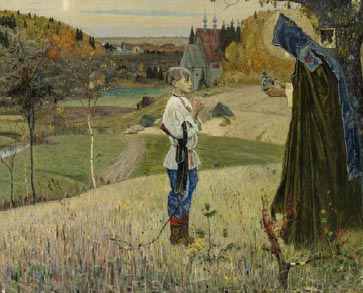 ork exhibition and was purchased by a well known collector of Russian Art.
ork exhibition and was purchased by a well known collector of Russian Art.Ms. Bekkerman said that the sale of that painting presented an incredible opportunity to purchase one of the most iconographic images in Russian art history. Masterpieces of this nature very rarely appear at auction. She considered it magnificent, in excellent condition and well documented.
3
 . “ Constantinople at Dawn”, a large-scale (42 ½ x 57 ins.) canvas by Ivan Konstantinovich Aivazovsky that melds the two most important themes of the artist's oeuvre - Constantinople and the seascape – was also offered. Once the capital of the Byzantine, Roman and Ottoman empires, and now the capital of Turkey, Constantinople (modern-day Istanbul) was still at the height of its glory when Aivazovsky first visited in 1845. In a letter from that same year, Aivazovsky expressed his particular enchantment with Constantinople: "there is nothing more majestic than this city; here one forgets both Naples and Venice." He was so captivated that he returned at least four more times during the course of his career. Aivazovsky painted numerous views of Constantinople under various light conditions, and throughout his prodigious career, he received important commissions and accolades from Russian Emperors and Sultans alike. The canvas exhibits a masterful evocation of the sun's early morning glow. Painted in 1851, one year after his most famous work, “The Ninth Wave”, which is in The State Russian Museum in St. Petersburg, the given work was estimated to sell for $2/3 million.
. “ Constantinople at Dawn”, a large-scale (42 ½ x 57 ins.) canvas by Ivan Konstantinovich Aivazovsky that melds the two most important themes of the artist's oeuvre - Constantinople and the seascape – was also offered. Once the capital of the Byzantine, Roman and Ottoman empires, and now the capital of Turkey, Constantinople (modern-day Istanbul) was still at the height of its glory when Aivazovsky first visited in 1845. In a letter from that same year, Aivazovsky expressed his particular enchantment with Constantinople: "there is nothing more majestic than this city; here one forgets both Naples and Venice." He was so captivated that he returned at least four more times during the course of his career. Aivazovsky painted numerous views of Constantinople under various light conditions, and throughout his prodigious career, he received important commissions and accolades from Russian Emperors and Sultans alike. The canvas exhibits a masterful evocation of the sun's early morning glow. Painted in 1851, one year after his most famous work, “The Ninth Wave”, which is in The State Russian Museum in St. Petersburg, the given work was estimated to sell for $2/3 million.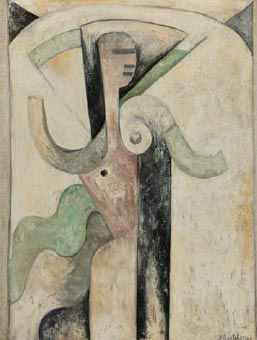 4. “Lady with a Parasol”, an important work by one of Russia's most important female artists, Natalia Sergeevna Goncharova, was also offered. In 1919 Goncharova moved permanently from Moscow to Paris where she focused her efforts on theatrical design and Diaghilev's Ballets Russes. She also continued to paint in oils and experimented with new methods of abstraction. “Lady with a Parasol” represents her interest in post-war Purism, an extension of Cubism that emphasized the aesthetic beauty and purity of form. Purism served as a reaction against the distortions and excesses of Cubism and Cubo-Futurism; it featured a reserved palette, flat surface and unbroken contour line. In the present work, Goncharova embraced a very familiar subject – one which had been portrayed by numerous painters, mostly the Impressionists, and one she herself had portrayed in at least two other compositions. Rather than merely dissecting her subjects, Goncharova reconstructed and elevated them, and in doing so she underscored the harmony and simplicity of their forms. Painted circa 1919-24, the given work was estimated to sell for $900,000/1.1 million (
4. “Lady with a Parasol”, an important work by one of Russia's most important female artists, Natalia Sergeevna Goncharova, was also offered. In 1919 Goncharova moved permanently from Moscow to Paris where she focused her efforts on theatrical design and Diaghilev's Ballets Russes. She also continued to paint in oils and experimented with new methods of abstraction. “Lady with a Parasol” represents her interest in post-war Purism, an extension of Cubism that emphasized the aesthetic beauty and purity of form. Purism served as a reaction against the distortions and excesses of Cubism and Cubo-Futurism; it featured a reserved palette, flat surface and unbroken contour line. In the present work, Goncharova embraced a very familiar subject – one which had been portrayed by numerous painters, mostly the Impressionists, and one she herself had portrayed in at least two other compositions. Rather than merely dissecting her subjects, Goncharova reconstructed and elevated them, and in doing so she underscored the harmony and simplicity of their forms. Painted circa 1919-24, the given work was estimated to sell for $900,000/1.1 million (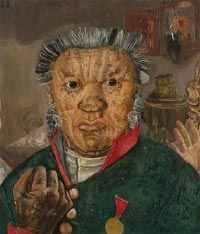 pictured right)
pictured right)5. The April sale presented an important offering of works by Boris Dmitrievich Grigoriev. Chief among them is “The Inspector General” which was painted more than a decade after the artist had established himself internationally, and which serves as a rare example of his return to Russian and theatrical themes later in his career (pictured detail right). Compositionally, Grigoriev's scene captures the very same eloquence of the gripping conclusion of Nikolai Gogol's famous play, "The Inspector General." In both the painting and the performance, the Governor stands at center while the entire cast poses simultaneously at either side, all shocked by the words they have just heard. Of course the real “satirical attack” of Gogol's “The Inspector General” is not just on the governor of the province, but also on the entire provincial social and political bureaucracy. Fittingly, Grigoriev depicts the central characters individually, giving each face its own characteristic, even comical expression, and dressing each body in distinctive, ostentatious costume. Meanwhile, at the edges and in the background, he hides the tired faces, soulful eyes and humble costume typical of his Faces of Russia cycle. He imbues these background figures-the poor and the helpless-with real emotion and thereby expresses his sympathy for them, placing them in stark contrast to the parodied and impractical social elite. Executed circa 1935, the work was estimated to sell for $800,000/1.2 million.

Boris Dmitrievich Grigoriev, The Inspector General, circa 1935,
est. $800,000/1.2 million
6
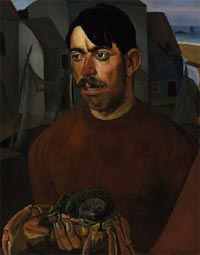 . An earlier work by Grigoriev, “Portrait of a Breton Peasant”, was also offered (pictured left). Throughout the 1920s Grigoriev took annual trips to Brittany in France. He, like many of his Russian contemporaries and artists before him, such as Paul Gauguin and Vincent van Gogh, championed the lifestyle of the Breton peasantry and memorialized them in his work. The present canvas dates to that period, and was estimated to sell for $400/600,000. Also by Grigoriev are two spectacular Portfolios of 58 Drawings and Gouaches; illustrations for Dostoevsky's “The Brothers Karamazov”. Dating from 1916 to 1932, the portfolios were estimated to sell for $250/350,000. This series, although well-documented and exhibited at the time of execution, was shown to the public for the first time since its completion. Grigoriev worked on this series for 16 years.
. An earlier work by Grigoriev, “Portrait of a Breton Peasant”, was also offered (pictured left). Throughout the 1920s Grigoriev took annual trips to Brittany in France. He, like many of his Russian contemporaries and artists before him, such as Paul Gauguin and Vincent van Gogh, championed the lifestyle of the Breton peasantry and memorialized them in his work. The present canvas dates to that period, and was estimated to sell for $400/600,000. Also by Grigoriev are two spectacular Portfolios of 58 Drawings and Gouaches; illustrations for Dostoevsky's “The Brothers Karamazov”. Dating from 1916 to 1932, the portfolios were estimated to sell for $250/350,000. This series, although well-documented and exhibited at the time of execution, was shown to the public for the first time since its completion. Grigoriev worked on this series for 16 years.7. Russian Contemporary Art
In July 1988 Sotheby's held the first auction of Russian avant-garde and Soviet contemporary art in Moscow, and on February 15, 2007 Sotheby's London held the first ever dedicated sale of Modern and Contemporary Russian Art. In keeping with that distinguished tradition, the April auction exemplified the wide range of subjects, styles, and approaches of important contemporary Russian artists who had far-reaching impact on the development of modernist art in the former Soviet Union. The sale included over forty works by major contemporary Russian artists from the late 1950s through the early 1990s.
By the late 1950s, as Soviet artists became more conscious of Western art movements, they responded in various ways, expressing their discontent with the official Socialist Realist aesthetics in preference to a wide range of modernist styles. Art became divided into “official” – which was given exhibition halls and government subsidies because it promoted ideas of Socialism and glorified the Soviet state, the industry and the Communist Party leaders – and “unofficial” or “nonconformist”, which was completely deprived of governmental support. In contrast to Socialist Realist artists, Soviet Nonconformist artists such as Oscar Rabin and Boris Sveshnikov always depicted the depressing nature of Soviet everyday existence. Rabin, called “Solzhenitsyn of painting,” was arrested several times for his nonconformist views and in 1978 was finally exiled from Russia. Instead of displaying officially-sanctioned images of Soviet prosperous life, Rabin depicted commonplace objects, depressing cityscapes, and religious symbols. Among the works by Rabin are “Bathhouse” (est. $70/90,000) and “Roses Above a City”, 1967 (est. $25/35,000). Boris Sveshnikov, who was deported to a hard-labor camp under the false accusation in anti-Soviet activities in 1946, was never able to forget the years spent there, and the camp became a major source for many of his works. His “Autumn Park” from 1962 was offered in the sale with an estimate of $30/35,000
Nonconformist art was not always narrative in nature, and not all nonconformist works can be regarded as political statements against the government. Nonconformist artists adopted and brought into the Russian context a wide range of modernist artistic practices, from Expressionism to Surrealism to Pop Art and abstraction, all of which were excluded by the Soviet censorship from the realm of official art. Among nonconformist artists who turned to various modernist styles and movements are Lydia Masterkova, Vladimir Nemukhin, Evgeny Rukhin, Mikhail Schwartsman, and Eduard Steinberg.
8
 . Sots Art
. Sots ArtMany Nonconformist artists created works which mocked the clichés of Socialist Realist art. The sale included two important works by Vitaly Komar and Alexander Melamid, who are most widely recognized as the originators of the "Sots Art" movement in the 1970s, in which they satirized Soviet culture by adapting the ideological style of Socialist Realism and parodying the heroic figures of their youth. Their “Still Life with Marx and Engels” 1981-82, and “Goat” from 1987-88 were estimated to bring $40/60,000 and $60/80,000 respectively. Sots Art works by Leonid Sokov, which ironically juxtapose images of the Western cultural icon Marilyn Monroe with the symbol of Soviet totalitarism Joseph Stalin, such as Marilyn and Stalin, 1989 (est. $10/15,000), were also included.
9. Conceptual Art
Conceptual artists' visual experiments with image and text were another important development in Nonconformist art, as exemplified by the works of Ilya Kabakov, Victor Pivovarov, and Svetlana Kopystiansky, including her “Dialogue”.
Also included in the sale was “Metamorphoses (self-portrait)” by one of the most important Conceptual artists in Moscow, Igor Makarevich . For Makarevich, who attended both the Moscow Art School and the Moscow Institute of Cinematography, photography has always been connected with conceptual art, and he was one of the first artists in Moscow to start using photography in this way. Makarevich's photo-series “Stratigraphic Structures-Changes”, of which “Metamorphoses” is a part, represents analytical research into the artist's own face and body as they slowly disappear under a gypsum mask. “Metamorphoses” is a black-and-white, earlier version of a work in the Norton and Nancy Dodge Collection of Soviet Nonconformist Art at the Zimmerli Art Museum at Rutgers University. As described by Makarevich, the work depicts the mutation of a human face as it undergoes a series of transformations, from plaster mask to shattered substance, and is connected to the idea of a continuously changing mask beyond which lies the abyss (бездна, пропасть). Executed in 1977-78, the work was estimated to sell for $10/15,000.
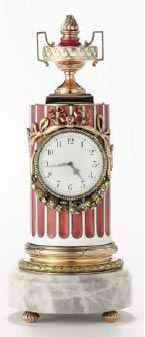 10. Applied Arts – April 16, 2007
10. Applied Arts – April 16, 2007Sotheby's Russian sale also featured outstanding selection of applied arts, including 18th and 19th century silver, porcelain, enamels, bronzes and works by Fabergé. Among the highlights is a Rare Fabergé Vari-Colored Gold and Enamel Column Form Timepiece, workmaster Henrik Wigstrom, St. Petersburg, circa 1900 (pictured left). Measuring just over eight inches in height, this stunning clock in translucent rose was estimated to sell for $1.5/2 million. Another outstanding rarity from the Fabergé workshops is a Highly Important Fabergé Gold and Enamel Bonbonnière in the form of a Miniature Empire-Style Armchair, workmaster Michael Perchin, St. Petersburg, 1899-1903. Enameled to imitate wood grain, it is a perfect miniaturization of a larger form and an extraordinary example of Fabergé's creative genius. Items of miniature furniture, such as this, are among the rarest of Fabergé's creations and only very few such examples have ever appeared at auction. The present example, which measures a mere 2 ¼ inches in height, was estimated to sell for $1/1.5 million.
A Monumental Fabergé Silver Kovsh, or drinking vessel, in the Old Russian style, drawing deeply on the Russian epic past, both in subject matter and decoration, was also offered. A surging group of helmeted and chain-mailed bogatyrs (Russian Medieval heroic warriors) form the handle while the incised decoration many of the shields recall traditional wood carving motifs. Increasing interest in the Muscovite past during the second half of the 19th century led to the establishment of art colonies, such as Abramtsevo founded by Savva Mamontov, and Princess Tenisheva's workshop at Talashkino, and found ultimate expression in such works of art as this kovsh by Fabergé. Measuring more than 23 inches in height, the given work was estimated to sell for $500/800,000. Also by Fabergé were a Silver Bird-Form Kovsh and a fine Silver-Mounted Cut-Glass Centerpiece, both from Moscow, circa 1900, and each estimated to sell for $250/350,000.
An important group of porcelain from the Imperial Porcelain Manufactory, St. Petersburg was also offered. Among this group were plates from military services dating from the reigns of Nicholas I through Alexander III with estimates ranging from $40,000 to $120,000. Also included were plates from the Kremlin service, and Two Exquisite Dessert Plates from the Coronation Service of Nicholas I, circa 1926 , painted royal blue and with the Imperial Eagle and chain of the Imperial order of St. Andrew, the plates were estimated to sell for $40/60,000 each.
The sale included a large selection of 19th century bronzes by such artists as Evgeni Lanceray and Vassili Grachev. Highlighting the group is an Impressive and Rare large Bronze Troika Group by Lanceray. Depicting a traditional, Russian troika group of a sled, carrying a seated couple, drawn by three horses, the given work was executed in 1881 and was estimated to sell for $80/120,000.
Pair – work
Task 18. Work with your partner.
- Let your fellow-student give you information about his (her) favorite museum. Try to get as many details as you can.
- Persuade your partner to agree with your opinion that life is made much more colorful if you regularly visit art exhibitions.
- One of you has just returned from England. The other is questioning him (her) on the impressions of the National Gallery The Tate Gallery etc.
- There is a qualitative difference between original art and photographic reproductions. Work in pairs and discuss this idea.
- Discuss with your partner the arguments for including popular arts such as posters, album covers, billboards, cinema and television in the Fine Arts.
- Modern art is rubbish and a daub of paint. Agree or disagree.
Task 19. Work with your partner
- Give a brief talk about an outstanding portrait painter. Choose one you really have a liking for.
- You are an expert on an outstanding landscape painter. Your fellow student will ask you questions to find out what you know about this painter.
- Make a note of the title of the picture that is well known. Tell the others about the picture. See if they can guess the title.
4. You are an expert on the Peredvizhniki Movement . Your partner is a foreigner who is completely ignorant of this period in the Russian Art history.
Group work
Task 20. Discuss in your group.
Topic I.
The appreciation of pictures is a special faculty (способность, дар) which only a few can possess.
Ideas:
- The excellency of style is not on the surface, but it lies deep. There is no need to be ashamed of one’s apparent dullness (тупость, глупость).
- The habit of looking at good picture is in itself a means by which taste can be formed.
- The acquisition of good taste is a matter of time. Painting in this respect doesn’t differ from other arts (poetry, music, etc.).
Topic II.
A great painting enriches our experience of life, just as a great poem does or a great musical composition.
Ideas:
- The more we look at the picture the more it reveals.
- Painters make us see and think a great deal more than the objects before us, they teach us to look at a scene through their eyes, their own imagination.
- The masterpieces of painting, like the masterpieces of music and poetry transform experience they are an inexhaustible source of beauty.
Role-play. Classroom debate.
Task 21. Choose a card representing one of the movements. Try to persuade other students that the style you present is the most important one. Speak in turns. You are welcome to ask each other any provocative questions.
Pop art
1. Popular arts are a reflection and product of popular culture and a part of our life. They include such forms as posters, albums covers, billboards, and particular cinema and television, etc. Popular art facilitates aesthetic experience and therefore is appropriate for study in the field of art education. Pop arts allow people to talk about emotionally meaningful experiences. They can help people understand their own present day culture much better.
Pop art and classical art
2. Sometimes the concepts of fine art and popular art are relative and the distinction between the two is slight. It is well known that many of the things we regard so highly today, such as Gothic cathedrals, El Grecos, Rembrandts, Goyas or Cézannes were ignored and scorned at different periods of time. The same thing may happen now. The things we ignore and scorn today may be considered to be unsurpassed masterpieces in future.
There can also be a reverse process. The things we appreciate very high now may be forgotten by future generations.
Classical art
3. Popular culture is the result of the public’s inability to appreciate high art. Serious art makes more demands on the viewer. Fine arts in each epoch supplied the models from which the rules and principles were derived. Tastes should be developed through images of high artistic culture, whereas works of popular culture as a rule meet the consumer’s tastes. Looking at good picture is a means by which taste can be formed. People need an uplifting experience, something noble and worthy.
Pop art
4. Young people prefer pop to the classical arts, pop concerts for example, or action movies. They are closer to their own experience of life and provide an emotional outlet (выход) and release. Picture galleries are for elderly spinsters with nothing to do. Lectures on classical art are too sophisticated, serious and dry to be listened to by young people. Modern life is stressful and common people need more relaxation.
Classical art
5. You are not a great art expert but you believe in handling down one’s cultural heritage from one generation to the next. Young people should not be allowed to remain indifferent to a wealth of classical heritage. The masterpieces of painting, like the masterpieces of music and poetry transform experience. They are an inexhaustible source of beauty which comes from the originality of the artist’s outlook, his capacity for combining form and color into a harmonious unity. Classical art should be preserved and cherished.
2.19. Quiz 1. Name the Picture.
Task 22. Guess the artist and the name of the picture reading these pieces of information.
1. A joyous picture that shows a Siberian game in which a horseman is jumping over a snow wall, defended by young people with twigs and whips.
2. A picture which depicts the moment of the Cossacks return from a successful campaign against Persia.
3. A portrait of Savva Mamontov's daughter.
4. “The singer of fields and forests”. One of his pictures depicted pine tree forest with wild animals climbing the trees.
5. A painting depicting birds and a tree in Early Spring, which was first exhibited in 1871.
6. A picture depicting a genre scene with a girl sorrowfully sitting at the pond and thinking about her disobedient brother.
- A painter, distinguished by his skilful use of light to bring the waves of the sea alive.
- A picture, depicting a young beautiful woman picking grapes in the afternoon on a hot summer day.
- A humorous genre scene, depicting a group of men, talking, relaxing and having a snack after hunting.
- A family portrait of father and daughters in the tragic moment of their life in a poor village. The man is a former mighty politician and a courtier.
11. The painting, showing a family surprised by an unexpected return of a political exile home.
2.20. Quiz 2. Name the Movement and Style.
Task 23. Guess the name of the described art movement
1. A Russian realistic school with democratic tendencies founded in 1971 as a contrast to the official Academy of Arts.
2. A movement of the beginning of the 19th century, representing a non- objective approach to painting, characterized by converting the represented forms into the essential geometric shapes: the cube, the sphere, the cylinder, and the cone.
3. A short-lived style, representing the crossing of reflected rays from various objects. Its most powerful tools are color and line.
4. The first systematic school of abstract painting in modern movement, developed by Kazimir Malevich in 1913 (the author of the famous “Black Quadrilateral on White”). (quadrilateral – четырехугольник)
5. The art, centered in Constantinople (now Istanbul), 5th century A.D. to 1453, which completely focused on the needs of the Orthodox Church, in the painting of icons and the decoration of churches with frescoes and mosaics.
6. A British form of historical painting in the second half of the 19th century, inspired by the art and architecture of Classical Greece and Rome.
7. An Italian Movement in the 15th century, representatives of which broke away from the restrictions of Byzantine Art and studied the natural world in order to perfect their understanding of such subjects as anatomy and perspective.
8. A light and spontaneous manner of painting which began in France in the 1960’s as a reaction against the restrictions and conventions of the dominant Academic art. The hallmark of the style is the attempt to capture the subjective impression of light in a scene.
9. A form of painting in which tiny dots of primary-colors are used to generate secondary colors.
10. A style of art which explores the everyday imagery that is so much a part of contemporary consumer culture. Common sources of imagery include advertisements, consumer product packaging, celebrity photographs, and comic strips.
11. The art of painting and sculpture produced under the influence of the Academies in Europe in the 19th century, characterized by its highly polished style, its use of mythological or historical subject matter, and its moralistic tone.
12. An approach to art in which subjects are depicted in as straightforward a manner as possible, without idealizing them.
Task 24. Give Russian eguivalents of the following paintings.
- Girl in the Sunlight
- The Rooks Have Returned
- Taking of a Snow Fort
- Mast-Tree Grove
- The Last Supper
- Trinity
- Barge Haulers on the Volga
- The Annunciation
- Italian Midday
- Rider
- Hunters at Rest
- Unknown Woman
- They Did Not Expect Him
- Above Eternal Peace
Writing
Task 25. Write a composition about your favourite picture or painter.
Topics for classroom presentations
1. The outstanding icon-painter Andrei Rublev.
2. Explain to your groupmates how to understand an icon painting.
3. Speak on the art of Wanderers.
- What V.Serov’s works do you remember? Why do they impress you?
- What can you say about Levitan’s ability to render atmosphere and light?
- Describe a painting by any of the Wanderers (speak about its subject, composition, colour, rendering of space, volume, perspective, motion and character).
- What is more important in portraits: likeness or psychology? Why?
- Describe any portrait you like, focus on the artist’s ability to capture the sitter’s inner world and personality traits.
- Who are your favourite Russian landscapers, architects, sculptors and why?
- Which of the landscape paintings do you like the most? Describe one of them.
- Do you understand Impressionism? What is it noted for?
- Speak about your favourite Russian painter and describe one or two of his works.
- Make a report about Tomsk painters and museums.
- Speak on the Russian handicraft.
- Advantages and disadvantages of pop art (classical art, etc.)
Russian Art Gazette
Editor-in-Chief Natalia Milovzorova
B
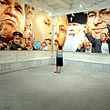 rian Droitcour. Painting of the Year
rian Droitcour. Painting of the YearBill Gates, Saddam Hussein and Alexander Litvinenko were among the figures in an epic collage called "2007."
Dmitry Vrubel and Viktoria Timofeyeva's "2007" is a monumental collage in oil paints that spans 21 meters on two walls of the Guelman Gallery at Winzavod. At one end, billionaire Roman Abramovich coquettishly peeks from behind a birch tree; at the other end sneers a gopnik, or street thug. In between, President Vladimir Putin wags a pistol, while kitty-corner from him U.S. President George W. Bush furrows his brow. Wedged between these massive portraits are scenes from recent Dissenters' Marches, smaller renditions of politicians ranging from Mayor Yury Luzhkov to former Prime Minister Mikhail Kasyanov, and the work's dealer, Marat Guelman. (The Moscow Times)
A
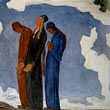 nna Malpas. Missing Links
nna Malpas. Missing LinksTwo Estonian paintings are no-shows at an exhibition celebrating EU-Russia solidarity. An exhibition displaying art from all the countries of the European Union, plus Russia, opened at the New Tretyakov Gallery this week. However, Estonia pulled its contribution of two paintings, citing security fears after the protests at the country's embassy in Moscow earlier this month. It sent only a video of artist Jaan Toomik ice-skating naked. (The Moscow Times)
O
 lesya Turkina. Contemporary Art in Russia – Newsletter No. 9, May 2007
lesya Turkina. Contemporary Art in Russia – Newsletter No. 9, May 2007The top event of spring 2007 was the Second Moscow Biennale of Contemporary Art. All exhibitions at the biennale were united under the rubric FOOTNOTES on Geopolitics, Market and Amnesia. Welcome to the ninth issue of the Contemporary Russian Art Newsletter! (newsletter.net.ru)
A
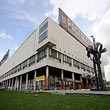 nna Malpas. Peep Show
nna Malpas. Peep ShowSeven artists, six days and 120 square meters of studio space raked by cameras were the ingredients of perhaps the most eye-catching show at the annual Art Moscow fair, which opened on Wednesday….(The Moscow Times)
Task 26 . Paraphrase and explain the meaning.
collage
coquettishly
kitty-corner
wedged between
no-show
Biennale of Contemporary Art
Footnotes
the most eye-catching
Unit 3. Russian Museums
10 museums, listed by popularity.
The State Tretyakov Gallery
The State Hermitage
The State Historical Museum
The Pushkin State Museum of Fine Arts
Federal State Institution "State Historical-cultural Museum-preserve “The Moscow Kremlin"
The State Darwin Museum
The State Russian Museum
The State Polytechnic Museum
The State Tretyakov Gallery (20th Century Collection)
The Vladimir & Suzdal Museum Complex of History, Art and Architecture
St. Petersburg’s Museums of Art and Culture
 | St. Petersburg's fabulous art galleries and culture museums rival the finest in the world, and include the unmissable State Hermitage Museum, as well as a host of lesser known collections charting the rich history of culture and art in the city.
|



